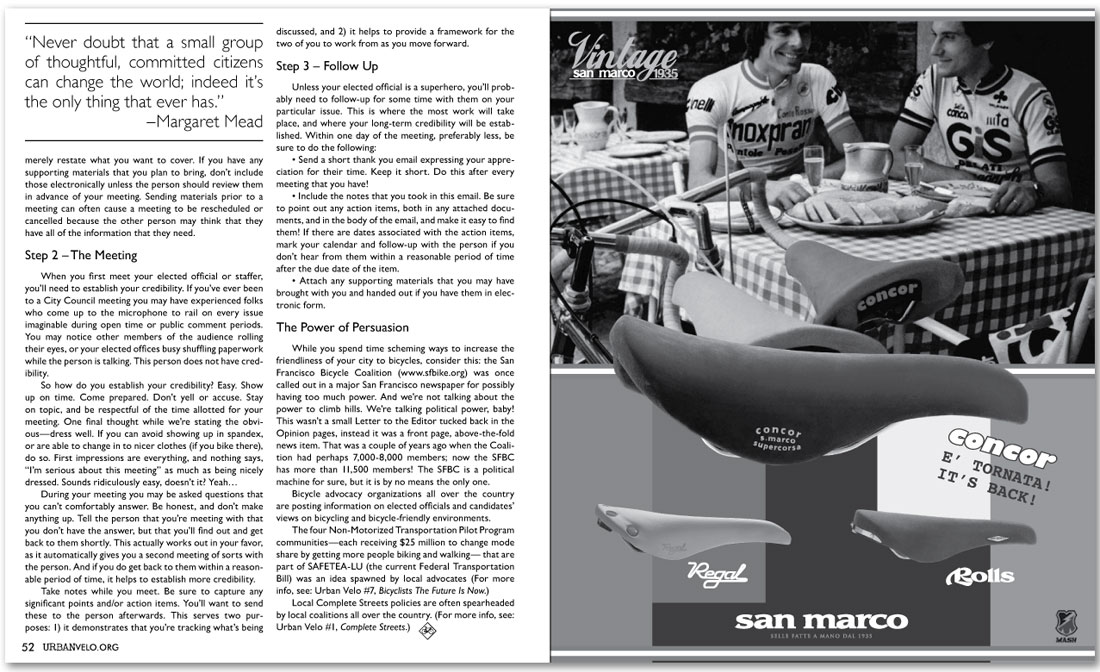| merely restate what you want to cover. If you have any supporting materials that you plan to bring, don’t include those electronically unless the person should review them in advance of your meeting. Sending materials prior to a meeting can often cause a meeting to be rescheduled or cancelled because the other person may think that they have all of the information that they need.
Step 2 – The Meeting
When you first meet your elected official or staffer, you’ll need to establish your credibility. If you’ve ever been to a City Council meeting you may have experienced folks who come up to the microphone to rail on every issue imaginable during open time or public comment periods. You may notice other members of the audience rolling their eyes, or your elected offices busy shuffling paperwork while the person is talking. This person does not have credibility.
So how do you establish your credibility? Easy. Show up on time. Come prepared. Don’t yell or accuse. Stay on topic, and be respectful of the time allotted for your meeting. One final thought while we’re stating the obvious—dress well. If you can avoid showing up in spandex, or are able to change in to nicer clothes (if you bike there), do so. First impressions are everything, and nothing says, “I’m serious about this meeting” as much as being nicely dressed. Sounds ridiculously easy, doesn’t it? Yeah…
During your meeting you may be asked questions that you can’t comfortably answer. Be honest, and don’t make anything up. Tell the person that you’re meeting with that you don’t have the answer, but that you’ll find out and get back to them shortly. This actually works out in your favor, as it automatically gives you a second meeting of sorts with the person. And if you do get back to them within a reasonable period of time, it helps to establish more credibility.
Take notes while you meet. Be sure to capture any significant points and/or action items. You’ll want to send these to the person afterwards. This serves two purposes: 1) it demonstrates that you’re tracking what’s being
discussed, and 2) it helps to provide a framework for the two of you to work from as you move forward.
Step 3 – Follow Up
Unless your elected official is a superhero, you’ll probably need to follow-up for some time with them on your particular issue. This is where the most work will take place, and where your long-term credibility will be established. Within one day of the meeting, preferably less, be sure to do the following:
• Send a short thank you email expressing your appreciation for their time. Keep it short. Do this after every meeting that you have!
• Include the notes that you took in this email. Be sure to point out any action items, both in any attached documents, and in the body of the email, and make it easy to find them! If there are dates associated with the action items, mark your calendar and follow-up with the person if you don’t hear from them within a reasonable period of time after the due date of the item.
• Attach any supporting materials that you may have brought with you and handed out if you have them in electronic form.
The Power of Persuasion
While you spend time scheming ways to increase the friendliness of your city to bicycles, consider this: the San Francisco Bicycle Coalition (www.sfbike.org) was once called out in a major San Francisco newspaper for possibly having too much power. And we’re not talking about the power to climb hills. We’re talking political power, baby! This wasn’t a small Letter to the Editor tucked back in the Opinion pages, instead it was a front page, above-the-fold news item. That was a couple of years ago when the Coalition had perhaps 7,000-8,000 members; now the SFBC has more than 11,500 members! The SFBC is a political machine for sure, but it is by no means the only one.
Bicycle advocacy organizations all over the country are posting information on elected officials and candidates’ views on bicycling and bicycle-friendly environments.
The four Non-Motorized Transportation Pilot Program communities—each receiving $25 million to change mode share by getting more people biking and walking— that are part of SAFETEA-LU (the current Federal Transportation Bill) was an idea spawned by local advocates (For more info, see: Urban Velo #7, Bicyclists The Future Is Now.)
Local Complete Streets policies are often spearheaded by local coalitions all over the country. (For more info, see: Urban Velo #1, Complete Streets.)
|
|
|

